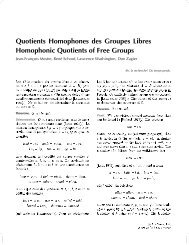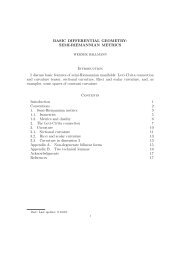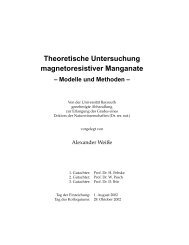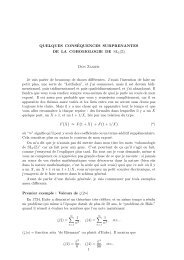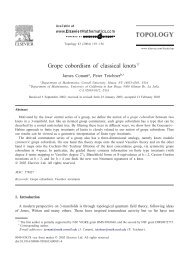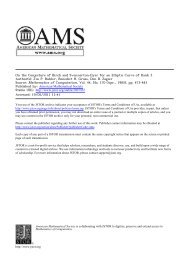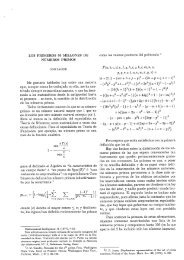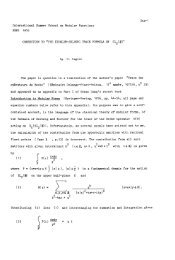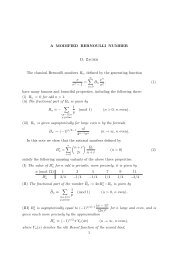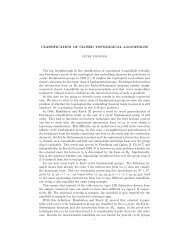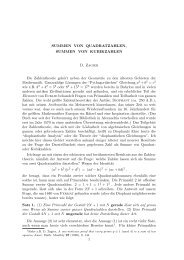Elliptic Modular Forms and Their Applications - Up To
Elliptic Modular Forms and Their Applications - Up To
Elliptic Modular Forms and Their Applications - Up To
Create successful ePaper yourself
Turn your PDF publications into a flip-book with our unique Google optimized e-Paper software.
22 D. Zagierpossible) <strong>and</strong> set h(z) = ( f(z)−a 0 E 4 (z) a E 6 (z) b) /Δ(z). This function is holomorphicin H (because Δ(z) ≠0) <strong>and</strong> also at infinity (because f − a 0 E a 4 Eb 6has a Fourier expansion with no constant term <strong>and</strong> the Fourier expansion ofΔ begins with q), so it is a modular form of weight k − 12. By induction onthe weight, h is a polynomial in E 4 <strong>and</strong> E 6 ,<strong>and</strong>thenfromf = a 0 E a 4 Eb 6 +Δh<strong>and</strong> (23) we see that f also is.In the above argument we used that Δ(z) has a Fourier expansion beginningq+O(q 2 ) <strong>and</strong> that Δ(z) is never zero in the upper half-plane. We deducedboth facts from the product expansion (22), but it is perhaps worth notingthat this is not necessary: if we were simply to define Δ(z) by equation (23),then the fact that its Fourier expansion begins with q would follow from theknowledge of the first two Fourier coefficients of E 4 <strong>and</strong> E 6 , <strong>and</strong> the fact thatit never vanishes in H would then follow from Proposition 2 because the totalnumber k/12 = 1 of Γ 1 -inequivalent zeros of Δ is completely accounted forby the first-order zero at infinity.We can now make the concrete normalization of the isomorphism betweenΓ 1 \H <strong>and</strong> P 1 (C) mentioned after Corollary 2 of Proposition 2. In the notationof that proposition, choose f(z) =E 4 (z) 3 <strong>and</strong> g(z) =Δ(z). <strong>Their</strong> quotient isthen the modular functionj(z) = E 4(z) 3Δ(z)= q −1 + 744 + 196884 q + 21493760 q 2 + ··· ,called the modular invariant. SinceΔ(z) ≠0for z ∈ H, this function is finitein H <strong>and</strong> defines an isomorphism from Γ 1 \H to C as well as from Γ 1 \H toP 1 (C).The next (<strong>and</strong> most interesting) remarks about Δ(z) concern its Fourierexpansion. By multiplying out the product in (22) we obtain the expansion∞∏ (Δ(z) = q 1 − q n ) 24 =n=1∞∑τ(n) q n (24)n=1where q = e 2πiz as usual (this is the last time we will repeat this!) <strong>and</strong> thecoefficients τ(n) are certain integers, the first values being given by the tablen 1 2 3 4 5 6 7 8 9 10τ(n) 1 −24 252 −1472 4830 −6048 −16744 84480 −113643 −115920Ramanujan calculated the first 30 values of τ(n) in 1915 <strong>and</strong> observed severalremarkable properties, notably the multiplicativity property that τ(pq) =τ(p)τ(q) if p <strong>and</strong> q are distinct primes (e.g., −6048 = −24 · 252 for p =2,q =3)<strong>and</strong>τ(p 2 )=τ(p) 2 − p 11 if p is prime (e.g., −1472 = (−24) 2 − 2048 forp =2). This was proved by Mordell the next year <strong>and</strong> later generalized byHecke to the theory of Hecke operators, which we will discuss in §4.Ramanujan also observed that |τ(p)| was bounded by 2p 5√ p for primesp



